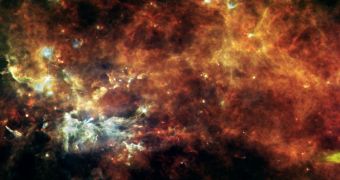Experts at the European Space Agency (ESA) are delighted to announce the one-year anniversary of the spectacular launch that saw two of the most advanced space telescopes ever built taken to Earth's orbit. On May 14, 2009, an Ariane 5 heavy-lift delivery system, carrying the Herschel Space Observatory and the Planck telescope roared in the skies above the Kourou Spaceport, in the French Guyana, South America. Even though only 12 months passed since, the two observatories are contributing significantly to changing and improving our understanding of the early Universe.
“The launch took place at 15:12 CEST. Shortly afterwards, both spacecraft separated according to plan: Herschel at 15:37:55 CEST followed by Planck at 15:40:25 CEST. The first signals from both were received by ESA’s New Norcia and Perth stations in Australia at 15:49 CEST. After a perfect injection by their Ariane 5 launcher, the commissioning of the scientific instruments and subsystems on both spacecraft began about a week later. The spacecraft arrived in their operational orbits in summer 2009. Now their rich flow of data is being analzsed by scientists on Earth. First results and images from both spacecraft have already been released and many more will follow,” ESA officials say in an official press release on their website.
Herschel made headlines fairly often over the past few months, given the 1,100+ previously-unseen galaxies that it discovered. Due to its incredibly-large observational power, it can make out very distant galaxies from the ubiquitous Cosmic Infrared Background (CIB), which is composed of IR radiation left behind since the time of the Big Bang. The datasets it sent back thus far give astronomers and astrophysicists additional details about how the early Universe evolved, as well as about how galaxies form and develop early on in their history.
On the other hand, Planck has kept mostly quiet about its mission, but the preliminary results of its survey are staggering. The instrument is currently engaged in a monumental task, and namely to map the distribution of dust and gas in our galaxy, and also to make sense of some of the most complex physical processes ever observed. These events take place when cosmic gas and dust mingle and interact with stars or with each other. Planck is also conducting an exhaustive investigation into the processes that underlie the formation of new, blue stars.

 14 DAY TRIAL //
14 DAY TRIAL //